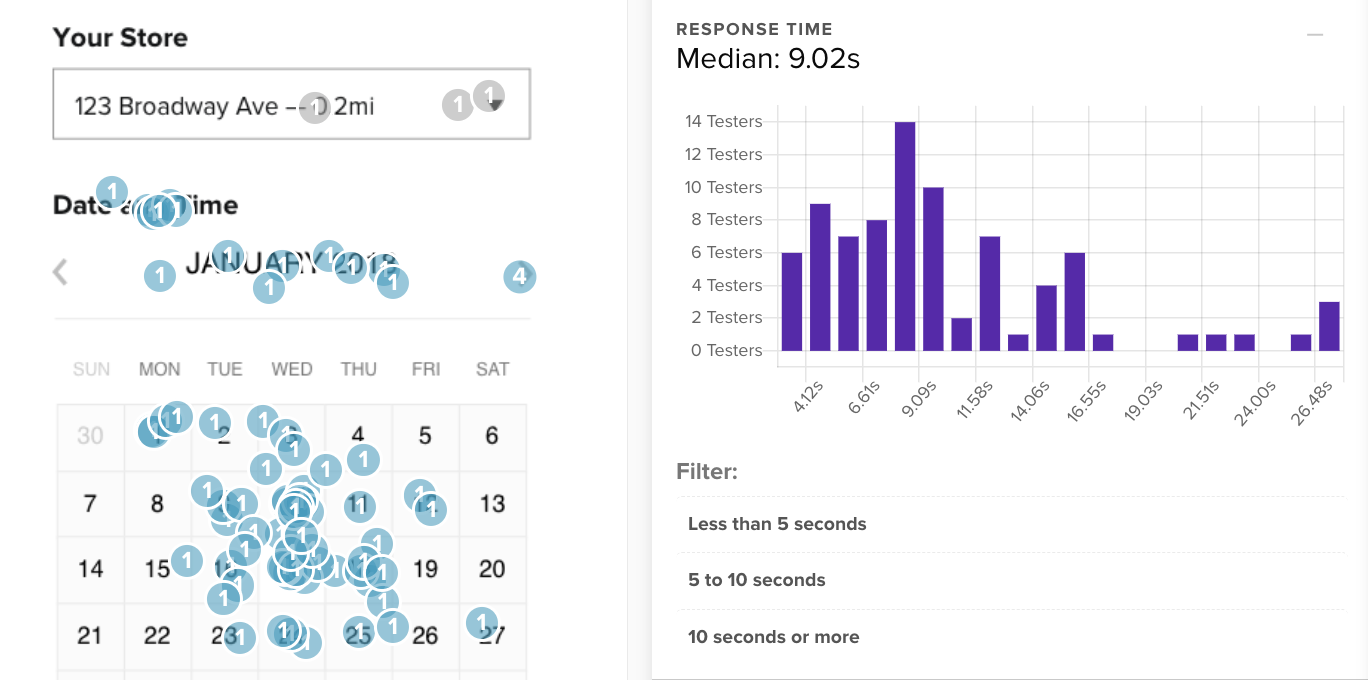10 UX Surveys Examples for Gathering User Feedback
User feedback is crucial to any successful user experience (UX) design. It helps designers understand what users think about their products and how to improve them. One effective way to gather user feedback is through UX surveys. This article will explore 10 examples of UX survey questions and how they can help you gather valuable insights from your users.
🔩 The Nuts and Bolts:
- Structured Framework for Comprehensive Feedback
UX Survey Examples provide a structured approach to capturing both qualitative and quantitative feedback, which is crucial for refining user experience. - Tailored Questions Uncover Hidden Pain Points
Businesses can pinpoint specific usability issues and opportunities for product enhancement through carefully designed UX survey examples. - Direct Line to User Preferences and Expectations
UX survey examples offer direct insights into user needs, facilitating the development of features and services that truly resonate with users. - Strategic Engagement Fosters User Loyalty
By soliciting feedback via UX Surveys Examples, companies demonstrate value for user input, fostering stronger engagement and brand loyalty. - Quantitative Data Guides Prioritization
Statistical insights from UX survey examples enable businesses to quantify user satisfaction and identify areas requiring immediate attention. - Qualitative Insights Fuel Innovation
Open-ended responses in UX survey examples provide rich, contextual insights, sparking innovation and guiding meaningful product improvements. - Continuous Feedback Loop Enhances Product Evolution
Regularly implementing UX survey examples creates a feedback loop, ensuring products evolve in alignment with shifting user expectations.
Understanding the Importance of User Feedback
Before diving into the world of UX surveys, it’s essential to understand why user feedback is so important. User feedback provides invaluable insights into how your product is being used, what works well, and what needs improvement. By collecting feedback, you can better understand your users’ needs and expectations, allowing you to make informed design decisions.
When users provide feedback, they offer a unique perspective that can uncover hidden pain points and highlight areas of your product that may require further attention. This feedback can help you identify usability issues, discover unexpected use cases, and even spark new ideas for future enhancements.
Moreover, user feedback is a direct line of communication between you and your users. It shows that you value their opinions and are committed to continuously improving their experience. This fosters a sense of trust and loyalty, as users feel heard and understood.
The Role of UX Surveys in User Feedback
UX surveys play a vital role in gathering user feedback. They provide a structured way to collect quantitative and qualitative data from your users. Surveys can help you measure user satisfaction, identify usability issues, and explore users’ desires and preferences.
You can obtain valuable statistical data that quantifies user sentiment and satisfaction levels with UX surveys. This data can be analyzed to identify trends and patterns, enabling you to prioritize improvements based on the most pressing user needs.
Additionally, UX surveys offer an opportunity to gather qualitative feedback, allowing users to express their thoughts and opinions in their own words. This qualitative data provides rich insights into the user experience, revealing specific pain points, delighters, and suggestions for improvement.
Combining quantitative and qualitative data, UX surveys comprehensively understand your users’ perspectives, helping you make data-driven decisions that align with their needs and expectations.
Benefits of Gathering User Feedback
Gathering user feedback offers several benefits. Firstly, it enables you to identify areas for improvement in your product. You can prioritize enhancements with the most significant impact by understanding where users are struggling or dissatisfied. This iterative approach to design ensures that your product evolves in line with user expectations.
Secondly, user feedback helps you validate design decisions as you can see how users respond to your product firsthand. It allows you to test assumptions and hypotheses, ensuring your design choices effectively resonate with your target audience.
Furthermore, user feedback fosters a sense of user-centricity, where the needs and preferences of your users drive your design decisions. By actively involving users in the design process, you create a product that meets their expectations, resulting in higher user satisfaction and engagement.
Lastly, gathering user feedback demonstrates transparency and accountability. It shows that you are committed to continuous improvement and value your users’ opinions and experiences. This can enhance your brand reputation and build stronger relationships with your user community.
Make your design decisions count.
Subscribe to Design Under Pressure. Get insights, UX metrics, and tools for bold, informed design.
We respect your inbox. Just insights. No fluff. Privacy Policy.
Crafting Effective UX Surveys
Crafting effective surveys is crucial to ensure your UX surveys provide meaningful results. Here are some key elements to consider:
Key Elements of a Successful UX Survey
A successful UX survey starts with clear goals and objectives. Define what you want to achieve with the study and what specific insights you are looking for. This will help you tailor your questions and gather the necessary data for your design decisions.
Another important element is keeping your survey concise and focused. While it may be tempting to include every possible question, overly long surveys can result in a high dropout rate. Users have limited time and attention span, so it’s essential to respect that and only ask for the most relevant information.
Using clear and simple language is also crucial in crafting an effective UX survey. Avoid using technical jargon or complex terminology that may confuse participants. The goal is to make the study accessible to a wide range of users, regardless of their level of expertise.
Additionally, providing options for open-ended responses can be valuable in capturing more nuanced feedback. While multiple-choice questions are useful for quantitative data, open-ended questions allow participants to express their thoughts and opinions in their own words. This qualitative data can provide deeper insights into user experiences.
Common Mistakes to Avoid in UX Surveys
When creating UX surveys, there are some common mistakes you should avoid. Firstly, avoid leading or biased questions that steer users towards a specific answer. Maintaining neutrality in your questions is essential to get honest and accurate feedback. Biased questions can unintentionally influence participants and compromise the validity of your survey results.
Another mistake to avoid is asking too many questions at once. While you may have a lot of valuable information to gather, bombarding users with an overwhelming number of questions can lead to survey fatigue. Users may rush through or abandon the survey, resulting in incomplete or unreliable data. Prioritize the most critical questions and break longer surveys into multiple shorter ones.
Lastly, always test your survey with a small group of users before distributing it widely. This pilot testing phase allows you to identify any issues or improvements in the survey design, question clarity, or response options. Gathering feedback from a small sample allows you to make necessary adjustments to ensure the survey is user-friendly and effectively captures the desired insights.
By considering these key elements and avoiding common mistakes, you can craft effective UX surveys that provide valuable insights into your product or service’s user experience.
Different Types of UX Surveys
Now that you understand the importance of user feedback and how to craft effective surveys let’s explore the types of UX surveys you can use. Each type of survey provides valuable insights into different aspects of your product’s user experience.
Satisfaction Surveys
Satisfaction surveys help you measure how satisfied users are with your product. These surveys assess various aspects of your product, such as ease of use, performance, and overall satisfaction. By understanding the level of satisfaction among your users, you can identify areas for improvement and prioritize enhancements. Examples of satisfaction survey questions include:
- “On a scale of 1 to 10, how would you rate your overall satisfaction with our product?”
- “What features do you find most valuable?”
- “How likely are you to continue using our product in the future?”
By asking these questions, you can gain insights into your product’s specific features and aspects that users appreciate the most. This information can guide your decision-making process and help you focus on enhancing the areas that matter most to your users.
Usability Surveys
Usability surveys focus on evaluating the usability of your product. These surveys help you identify where users encounter difficulties or confusion while using your product. By understanding your users’ pain points and challenges, you can make informed design decisions to improve the overall user experience. Usability survey questions may include:
- “How easy was it to complete your intended task?”
- “Did you encounter any issues or errors while interacting with our product?”
- “Which specific features or interactions were the most challenging for you?”
Through usability surveys, you can gather feedback on specific interactions or features that need improvement. This feedback can help you streamline workflows, simplify complex tasks, and eliminate barriers that hinder users from achieving their goals efficiently.
Desirability Surveys
Desirability surveys gauge users’ desires and preferences regarding your product. These surveys aim to understand what features or aspects of your product attract users and how they perceive your product compared to competitors. By understanding the desirability of your product, you can align your design and marketing strategies better to meet the needs and expectations of your target audience. Desirability survey questions may include:
- “How likely are you to recommend our product to a friend or colleague?”
- “What aspects of our product do you find most appealing?”
- “What improvements or additions would make our product more desirable to you?”
Through desirability surveys, you can gain insights into your product’s unique selling points and understand how it differentiates from competitors. This information can help refine your product’s value proposition and tailor your marketing messages to resonate with your target audience.
By utilizing different types of UX surveys, you can comprehensively understand your users’ perspectives and experiences. This knowledge empowers you to make data-driven decisions, prioritize improvements, and create a user-centered product that delights your target audience.
🚀 If you’re using Helio
Make data-driven decisions, prioritize improvements, and create a user-centered product that delights your target audience.

Help refine your product’s value proposition and tailor your marketing messages.
Analyzing UX Survey Results
Once you’ve collected user feedback through surveys, analyzing the results effectively is vital. Here are two critical steps in the analysis process:
Interpreting User Feedback
Interpreting user feedback involves looking for patterns, trends, and common themes in the survey responses—grouping similar feedback to identify recurring issues or positive aspects of your product. Pay attention to quantitative data, such as satisfaction ratings, and qualitative data, like open-ended responses, to understand user sentiment comprehensively.
Turning Feedback into Actionable Insights
After interpreting user feedback, it’s time to turn it into actionable insights. Prioritize the issues or areas for improvement based on their impact on the user experience. Use the insights from the survey to inform your design decisions and guide the implementation of changes to your product.
Implementing Changes Based on User Feedback
Gathering user feedback is only the first step. To create a user-centric product, it’s essential to implement changes based on the feedback you receive. Here’s what you need to consider:
Prioritizing User Feedback
Not all feedback is created equal, so it’s crucial to prioritize it. Focus on the feedback that aligns with your product goals and significantly impacts user experience. Consider the frequency and severity of the feedback and weigh it against your available resources. Implement changes that address the most critical issues or improvements.
Incorporating Feedback into UX Design
Finally, incorporate user feedback into your UX design process. Use survey insights to inform your design decisions and iterate on your product. Gather feedback regularly to ensure you continue to meet users’ evolving needs and expectations.
Using UX surveys to gather feedback, you can better understand your users, improve your product, and create a delightful user experience. Explore the different types of surveys and experiment with different survey questions to find the best approach for your product and your users.
Remember, user feedback is a continuous process, so make it a habit to regularly gather feedback and iterate on your product based on the insights gained. Happy surveying!
UX Survey FAQs
UX Surveys Examples are specific questionnaires designed to gather feedback on the user experience of a product or service. They are crucial for understanding how users interact with a product, identifying areas for improvement, and ensuring that design decisions align with user needs and preferences.
Effective UX surveys should have clear objectives, ask concise and relevant questions, and be designed with the target audience in mind. They should also include a mix of question types to gather both quantitative and qualitative feedback and be user-friendly to encourage participation.
UX surveys may include satisfaction questions to measure user contentment, usability questions to assess ease of use, and desirability questions to understand user preferences. These surveys often combine multiple-choice, rating scales, and open-ended questions to capture a wide range of insights.
To increase participation, businesses can keep surveys short and engaging, offer incentives for completing them, use clear and engaging language, and distribute them through multiple channels. Sending reminders and expressing appreciation for feedback can also encourage more users to participate.
Analyzing UX survey data involves identifying patterns, trends, and key insights from quantitative and qualitative feedback. Businesses should prioritize feedback based on its impact on the user experience and use these insights to guide design improvements and strategic decisions.
Common mistakes include asking leading or biased questions, making surveys too long or complex, and failing to test the study with a small user group before broader distribution. Avoiding these pitfalls ensures more reliable data and higher-quality user feedback.
Translating UX survey insights into product improvements involves prioritizing user feedback, incorporating it into the UX design process, and continuously testing and iterating based on new feedback. This approach ensures that products evolve to meet and exceed user expectations.



